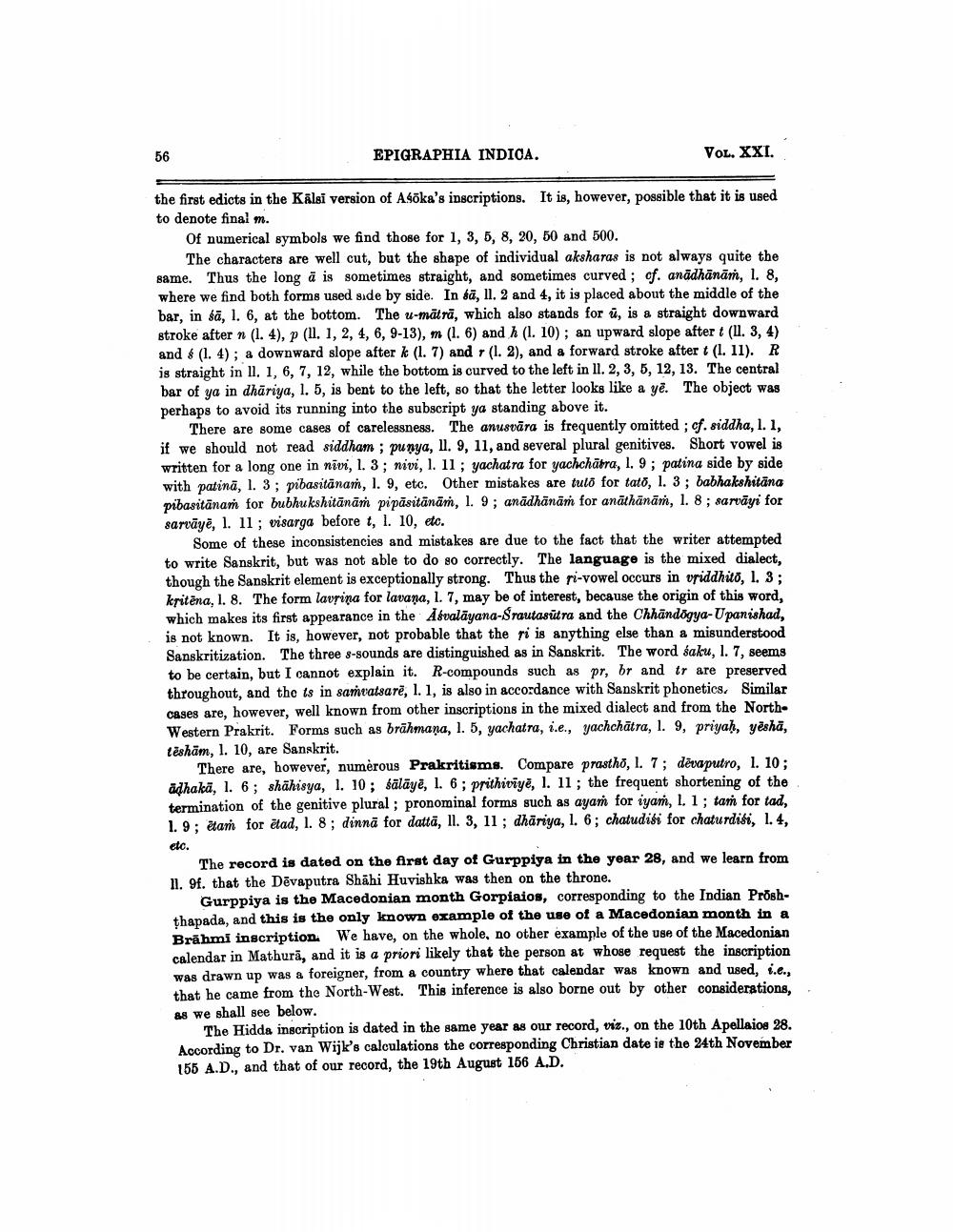________________
EPIGRAPHIA INDICA.
VOL. XXI.
the first edicts in the Kälsi version of Asöka's inscriptions. It is, however, possible that it is used to denote final m.
Of numerical symbols we find those for 1, 3, 5, 8, 20, 50 and 500.
The characters are well cut, but the shape of individual aksharas is not always quite the same. Thus the long ä is sometimes straight, and sometimes curved ; of. anādhānāṁ, 1. 8, where we find both forms used side by side. In sā, II. 2 and 4, it is placed about the middle of the bar, in sā, 1. 6, at the bottom. The u-mätrā, which also stands for ů, is a straight downward stroke after n (1. 4), p (11. 1, 2, 4, 6, 9-13), m (1. 6) and h (1. 10); an upward slope after t (1. 3, 4) and 6 (1.4); a downward slope after k (1. 7) and (1.2), and a forward stroke after t (1. 11). R is straight in 11. 1, 6, 7, 12, while the bottom is curved to the left in Il. 2, 3, 5, 12, 13. The central bar of ya in dhāriya, 1. 5, is bent to the left, so that the letter looks like a ye. The object was perhaps to avoid its running into the subscript ya standing above it.
There are some cases of carelessness. The anusvāra is frequently omitted ; cf. siddha, 1. 1, if we should not read siddham ; punya, 11. 9, 11, and several plural genitives. Short vowel is written for a long one in nīvi, 1. 3 ; nivi, 1. 11; yachatra for yachchātra, 1. 9; patina side by side with patinā, l. 3; pibasitānam, 1. 9, etc. Other mistakes are tulo for tato, I. 3; babhakshitana pibasitānam for bubhukshitānāṁ pipāsitānām, 1. 9; anādhānām for anāthānām, 1. 8; sarvāyi for sarvāye, 1. 11; visarga before t, 1. 10, etc.
Some of these inconsistencies and mistakes are due to the fact that the writer attempted to write Sanskrit, but was not able to do so correctly. The language is the mixed dialect, though the Sanskrit element is exceptionally strong. Thus the ri-vowel occurs in vsiddhito, I. 3; kritēna, 1. 8. The form lavrina for lavana, L. 7, may be of interest, because the origin of this word, which makes its first appearance in the Asvalāyana-Srautasutra and the Chhändögya-Upanishad, is not known. It is, however, not probable that the ri is anything else than a misunderstood Sanskritization. The three s-sounds are distinguished as in Sanskrit. The word saku, 1. 7, seems to be certain, but I cannot explain it. R-compounds such as pr, br and tr are preserved throughout, and the is in samvatsaré, I. 1, is also in accordance with Sanskrit phonetics. Similar cases are, however, well known from other inscriptions in the mixed dialect and from the NorthWestern Prakrit. Forms such as brāhmana, l. 5, yachatra, i.e., yachchātra, 1. 9, priyah, yesha, tëshām, 1. 10, are Sanskrit.
There are, however, numerous Prakritisms. Compare prastho, 1. 7; dēva putro, 1. 10; adhaka. 1. 6; shāhisya, I. 10; sālāye, I. 6; prithiviye, I. 11; the frequent shortening of the termination of the genitive plural; pronominal forms such as ayan for iyan, 1. 1; tam for tad, 1.9: etaṁ for ētad, 1. 8; dinnā for dattā, ll. 3, 11 ; dhåriya, 1. 6; chatudisi for chaturdisi. .4. etc.
The record is dated on the first day of Gurppiya in the year 28, and we learn from 11. 9f. that the Dēvaputra Shāhi Huvishka was then on the throne.
Gurppiya is the Macedonian month Gorpiaios, corresponding to the Indian Prðshthapada, and this is the only known example of the use of a Macedonian month in a Brahmi inscription. We have, on the whole, no other example of the use of the Macedonian calendar in Mathurā, and it is a priori likely that the person at whose request the inscription was drawn up was a foreigner, from a country where that calendar was known and used, i.e., that he came from the North-West. This inference is also borne out by other considerations, & we shall see below.
The Hidda inscription is dated in the same year as our record, viz., on the 10th Apellaios 28. According to Dr. van Wijk's calculations the corresponding Christian date ie the 24th November 158 A.D., and that of our record, the 19th August 166 A.D.




